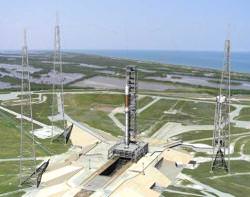We’ve already learned that NASA is planning to build one of the world’s largest roller coasters to help astronauts escape a disaster. Now they’ve released details about how they’re going to protect the next generation spacecraft from lightning strikes. They’ll need it. This is Florida after all, one of the most active regions for lightning in the United States.
When the space shuttle finally retires in 2010, NASA will be nearly ready to start launching the next generation Ares I launch vehicle. A single lightning strike could scramble spacecraft electronics, or injure the crew, so NASA is working on their defense system.
And for Ares, they’re going to big. In fact, when you look at the Ares I launch pad in a few years, the lightning protection system will dominate the skyline.
The lightning protection system, now under construction at Kennedy Space Center’s launch pad 39B consists of three towers – each of which will be 181 metres (594 feet) tall. Cables will then be strung between the steel/fibreglass towers, encasing the smaller Ares I booster in a cage of protection.
Similar, smaller systems have been used for other missions in the past. For the Apollo launchers, the protection system was built into the launch structure. Obviously this was less than ideal, since lightning strikes could still damage the rocket and electronics.
For the space shuttle, there’s a lightning mast atop the launch pad’s service structure. The system diverts lightning strikes down two wires, keeping the current away from the shuttle.
By building these towers completely apart from the launch pad, NASA hopes to minimize delays to the launch schedule.
Construction for the towers began in November, and should be complete by 2010. This will actually be a little after the first Ares I-X rocket blasts off, in April 2009.
Original Source: NASA News Release


The lightning protection will take longer to build than the actual rocket? Sounds nice.